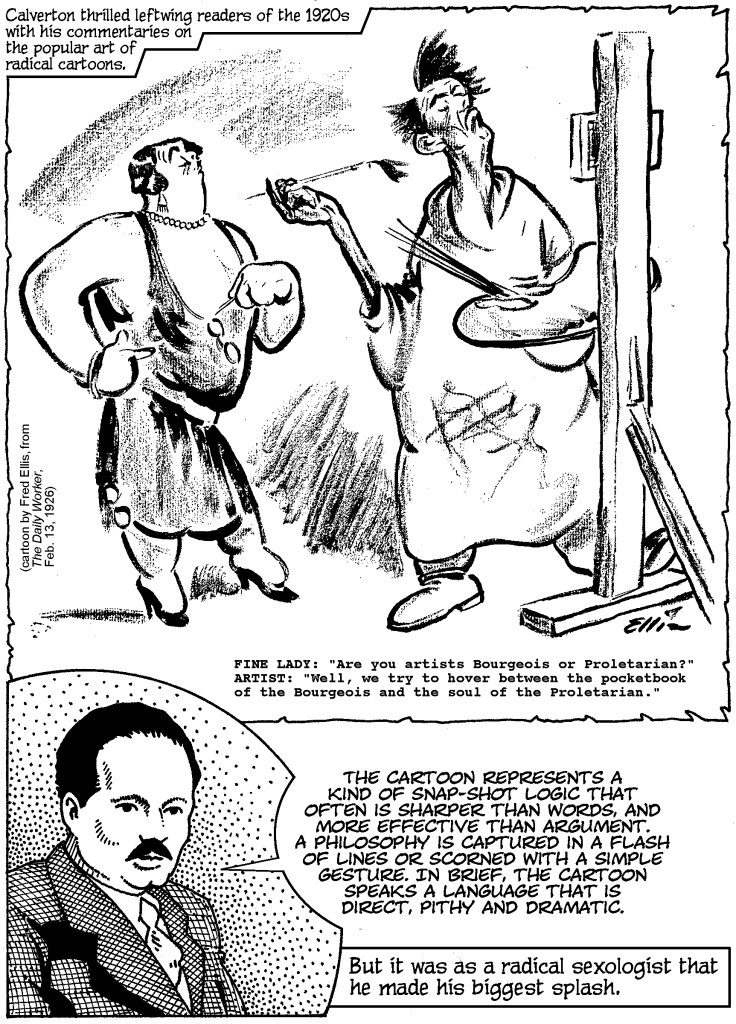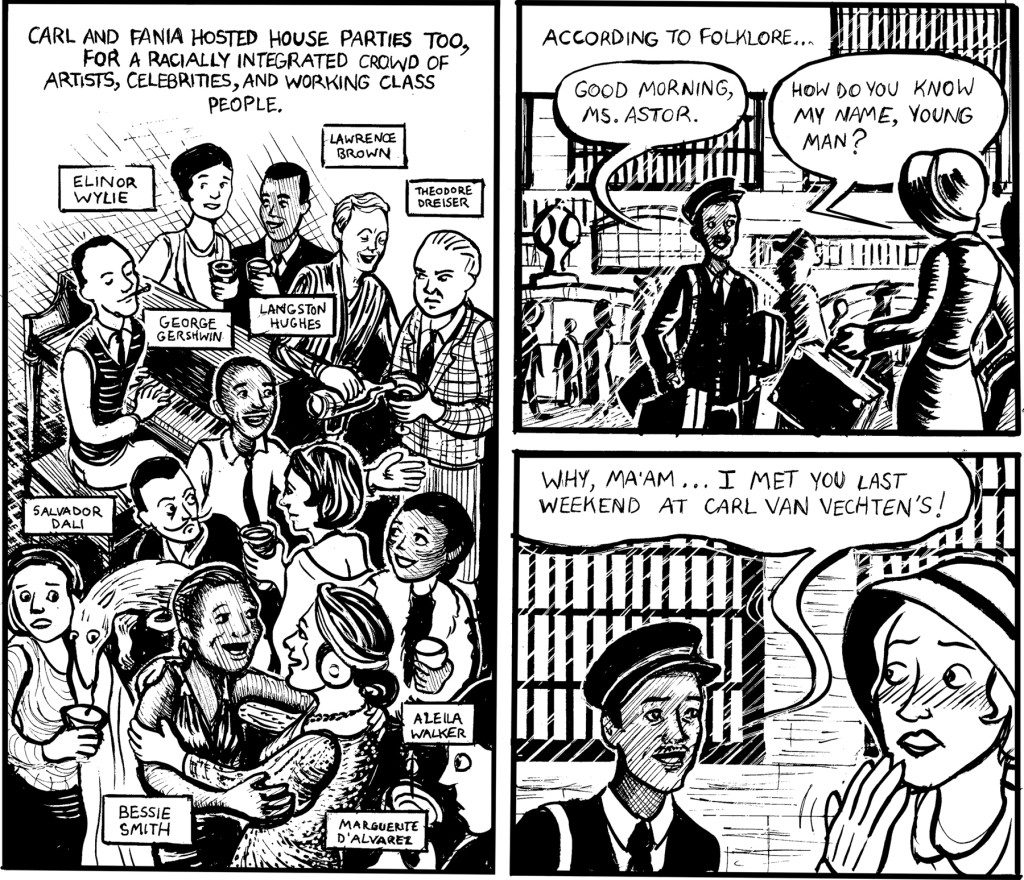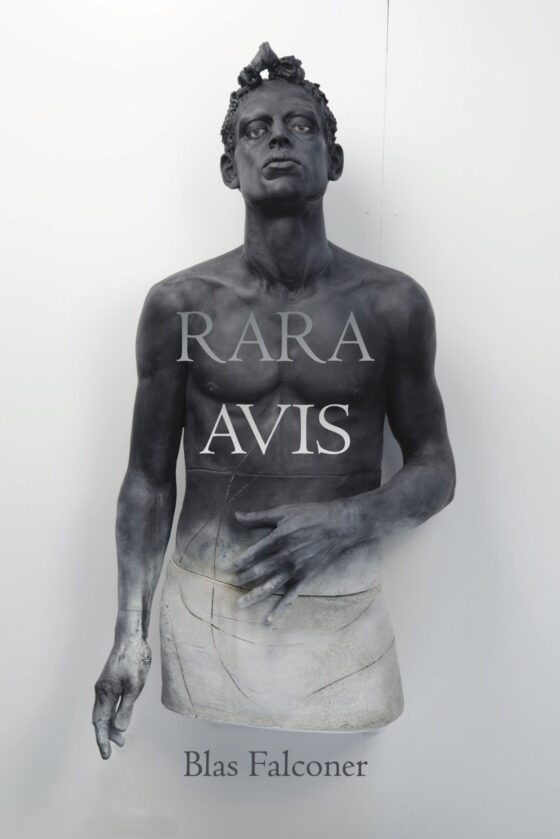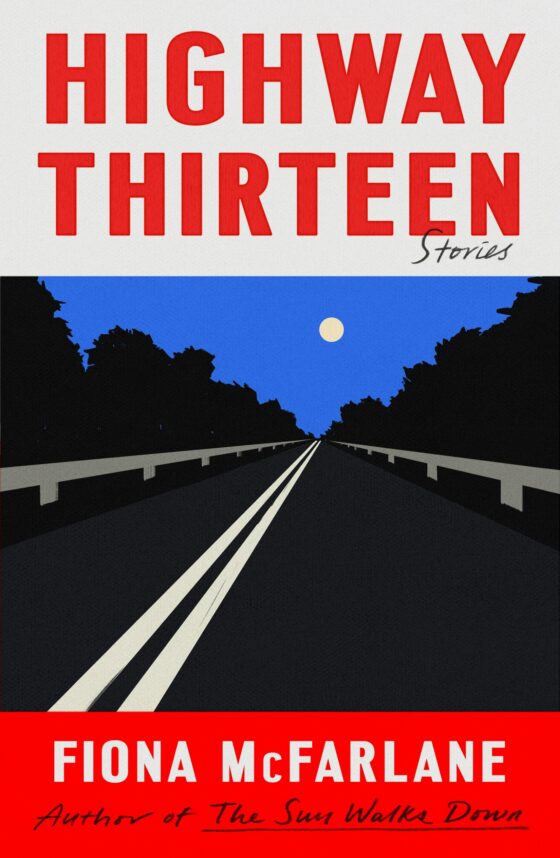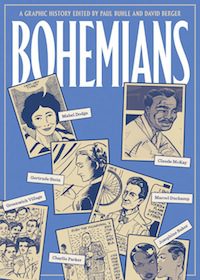
The etymological roots of bohemian—bohème in French—come from a mistake by nineteenth-century French journalists who incorrectly reported that the Romani people originated in Czech-Bohemia. It’s now known that they emigrated from the Indian subcontinent some thousand years ago, but since Shakespeare, Romani culture has been romanticized by any number of European writers, from John Clare to George Eliot to Guy de Maupassant. Writers and artists were fascinated with the supposed free-spiritedness, wanderlust, and musicality of the Romani, and all three themes feature prominently in the lives of the men and women in Bohemians: A Graphic History edited by Paul Buhle and David Berger.
First and foremost, bohemian culture conjures visions of Paris’s Left Bank, thanks in large part to Henri Murger’s 1851 Scènes de la vie de bohème, a semi-autobiographical account of life in the city’s Latin Quarter. Initially popularized in Parisian theater, it became the source material for Puccini’s La bohème, later updated to Manhattan’s Lower East Side in Rent. All this is to say that the image of the bohemian has seeped into our culture since Murger’s novel and firsthand reports from travelers made their way to the states in the 1850s.
Despite Paris’s primary place in the bohemian story, Buhle and Berger choose to narrow their gaze on bohemianism in the United States, especially New York City, though there is a great deal of cross-pollination with Paris up until World War II. This focus on American iterations of European radical ideas is something Buhle has returned to throughout his career. His masterwork, Marxism in the United States, follows the trajectory of socialism that first crossed the Atlantic on waves of immigrants forced to reformulate their politics to fit the American condition. Buhle is also the founder of the archive Oral History of the American Left, and his use of firsthand accounts in his histories is unique. Bohemians also remains in keeping with Buhle’s commitment to the graphic novel as a meaningful form. One of Bohemians’ characters, radical sexologist V. F. Calverton, remarks: “The cartoon represents a kind of snap-shot logic that often is sharper than words, and more effective than argument.”
So, what is a bohemian? Neither Buhle and Berger nor the host of scriptwriters and artists attempt a systematic answer to the question, and with good reason. The lines between bohemian, radical, bourgeois dilettante, and artist bleed into one another. In the book, the best response to this question is in “‘The Sex Boys’ and the Libidinal Left.” Artist Matt Howarth recreates a 1926 Fred Ellis cartoon published in The Daily Worker. A caricatured “fine lady” with pearls and opera spectacles looks over the shoulder of an “artist” in a formless, paint-smeared smock:
FINE LADY: “Are you artists Bourgeois or Proletarian?”
ARTIST: “Well, we try to hover between the pocketbook of the Bourgeois and the soul of the Proletarian.”
An excellent evasion by a group more identifiable by what it wasn’t than what it was. Bohemians never coalesced around any strict set of ideologies, although if one wanted to pin down any commonalities here are two: individualism and unswerving devotion to free love. Every person detailed in the book is a character, larger than life and unique. From its earliest American interpreters, the Unitary House—pilloried by the New York Times in 1860 as “the latest and most repulsive development of the free-love system”—to Billie Holiday and Woody Guthrie, free love remained the cornerstone of bohemian lifestyle. [1] Greenwich Village bohemians like Mabel Dodge, and radical anarchists of the Lower East Side like Emma Goldman, could all agree that the bedroom was no one else’s business. Bohemians, always individualistic, shared with anarchists concerns over personal freedom even if they were not often found on the front lines of political action.
White bohemians may not have been big on mass politics, they were in no ways as reactionary as the Beats. Black bohemians, however, had little choice but to confront the bitter racism that hounded them. This racism took on many guises. Walter “Stretch” Johnson recalled Manhattan club owners who “exploited the entertainers as if they were sharecroppers in the deep South.” Exploitation and voyeurism in its worst forms plagued the New York club scene and white interest in Harlem culture. White critics “scoffed at the ‘bare chests and midriffs’ of the dancers” in choreographer Katherine Dunham’s shows, at the same time believing such observations complimented black artists because “savage” or “primitive” performances were perceived to be authentic. Praise like this was very difficult for black bohemians to swallow. This is not to say that white bohemians were unsympathetic—they were mostly forward-thinking in terms of race—but the fact remains that they didn’t always contradict ignorant statements in the press or boycott clubs that mistreated or barred their black counterparts.
According to Buhle and Berger, Bohemians is “a thematic successor” (as well as precursor) to the 2007 publication of The Beats: A Graphic History. But where Beats has a literary, narrative style, Bohemians opts for more of a chronological, encyclopedic format. This is partly because American bohemianism was never a single crystallized movement centered around a shared aesthetic or coterie like the Beats. Its history is freewheeling and big-tent. From the late Spain Rodriguez, the underground comix legend, to Dan Steffan’s steampunk style, to the modern stylings of Afua Richardson, there is a bewildering amount of variety, and their different styles help to keep all the stories and subjects separate. Bohemians also makes good use of primary sources for dialogue or script. Whitman’s “Crossing Brooklyn Ferry” is given a wonderful visual treatment, as are excerpts from Yiddish playwright Leon Kobrin’s The Tenement House, and a sequence of Claude McKay’s poems shows the breadth of his experiences.
Some of the lack of cohesion is probably due to the fact that Buhle’s longtime collaborator Harvey Pekar is no longer living. Pekar contributed greatly to Beats, Wobblies! A Graphic History of the Industrial Workers of the World, and Students for a Democratic Society: A Graphic History, making appearances in several of them as a sort of guide, similar to Larry Gonick in Cartoon History of the Universe. Pekar’s deft touch is missing from Bohemians, making it a bit less cohesive than Beats. But there is a nice coda for the Cleveland bohemians Pekar and R. Crumb, and it’s clear that Pekar is much missed.
Because it is a companion to Buhle’s and Pekar’s history of the Beats, Bohemians provides more historical underpinnings for how the bohemian morphed into the modern “hipster.” [2] Toward the end of Bohemians, artist Nick Thorkleson introduces bebop, which Buhle et al. trumpet as the final phase of amorphous, freewheeling bohemianism. Bebop played up one of the fundamental tensions of New York City bohemianism: the appropriation of uptown black culture by downtown whites. [3] Thorkelson describes a hipster as “a thoroughly masculine but racially ambiguous template for the American bohemian… for some the hipsters were downwardly mobile whites mimicking upwardly mobile black artists.” This is a pattern that has persisted long beyond bebop’s heyday, even though the hipster no longer revolves exclusively around jazz music.
Buhle and Berger end the book asking where bohemia stands in the twenty-first century. They hope it’s still possible for bohemians to find avenues of resistance. But this seems unlikely after the significant ruptures that occurred in the 1960s. For one thing, the press shifted its coverage to movements whose boundaries were more easily identifiable, [4] such as the Beats, who had a literary and sartorial style that was easy to latch onto. Just as significant was the apotheosis of individualism, a hallmark of bohemian life. When the dust settled on the ’60s, individualism had been commodified by ad agencies and marketing firms—what Thomas Frank dubbed “the conquest of cool.” [5] Everyone now believes in the power of the individual. What is there to resist when no one is that upset when you live at the cultural margins? What even constitutes the cultural margins?
Bohemians were never as daring as the Wobblies, anarchists, or civil rights activists. Their willingness to remain aloof relegates their influence to something more tenuous and utopian, while at the same time underscoring the continual triumph of American bourgeois life. They represent a very dangerous propensity toward dilettantism, what Foucault once called a “febrile indolence.” This seems to be the one defining characteristic of our modern bohemians; culture surfers endlessly picking through era after era, consuming ideas and fashions and giving rise to the curated life. If the bohemians of yore had a saving grace, it’s that there was still something deeply felt and dangerous about their choices to live outside accepted lines, to mix freely with different people, to believe that art had transgressive qualities and wasn’t just a word deployed to make commercialism appear authentic. Bohemians provides the origin story of American counter-culture, which makes for an interesting, enjoyable read. But it’s also cautionary tale about the limits of individualism as a transformative politics.
[1] This is not to say that it didn’t pose problems, both personal and societal.
